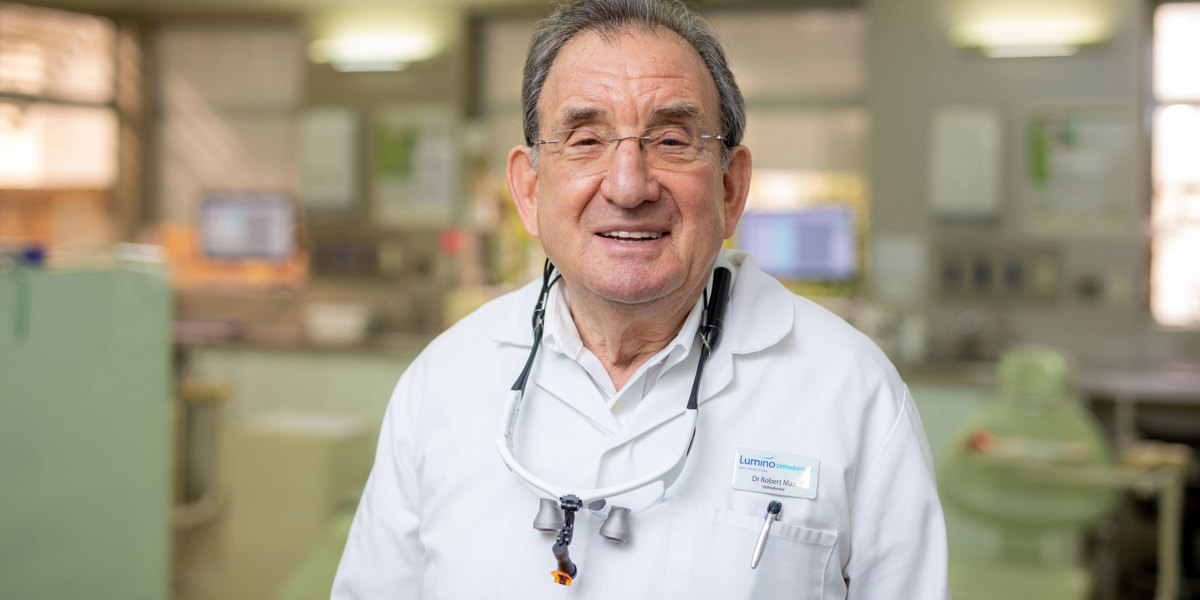
Fifty-one years in dentistry is both an achievement and a demonstration of true dedication to oral health. Lumino Max and Beresford's, Dr Robert Max will be missed as he steps away from orthodontics for a well-deserved retirement, later this year.
Robert has wonderful memories from his time in dentistry and has built an amazing intergenerational following at his practice, Lumino Orthodontists Max & Beresford, in Auckland.
We caught up with him to learn about his career, his thoughts about orthodontics through the years, and why he loves orthodontics.
Graduating from the University of Otago with a BDS, Robert spent two and a half years in a general dental practice in central Auckland. However, from early days he had an ambition to study orthodontics. It offered a satisfying combination of biological science and the principles of mechanical engineering, together with the reward that comes from making lasting, positive changes for dental health and personal wellbeing.
A prerequisite was spending six months in hospital dentistry in a paediatric dental department. He was appalled by the number of children he saw in (at that time) non-fluoridated London, with rampant caries, the 'Ribena babies', who had been put to bed sucking a bottle of Ribena.
His specialist training was at the Royal Dental Hospital in Leicester Square, from which he graduated D.Orth.RCS (Eng).
Returning to Auckland in 1970, he entered orthodontic practice with Dr Ron Tonkin, Dr John Tonkin and Dr Pat Bell. In the early days of his specialist career, he also worked in Takapuna one afternoon a month and in Whangarei for two and a half days a month.
From 1973 to 1990 Robert spent one and a half days a week at the plastic surgical dental unit at Middlemore Hospital, under the leadership initially of Sir William Manchester, treating children and young people who had cleft lip and palate.
The bigger oral health picture has always interested Robert. He was saddened by the then-ubiquitous total tooth loss of many adult New Zealanders, who were identifiable by the shrunken middle third of their face and the prevalence of denture-wearing. However, he has been encouraged by the dramatic decrease in this situation since about 1976, with more adults retaining their natural teeth into older age. This provides a situation where specialists can thrive, in an environment focused on protecting and giving longevity to the original teeth.
He attributes this improvement in large part to the introduction of school dental services and to fluoridation. Robert has observed the reduction in rampant caries, (although there is a slight increase in fluorosis). He was pleased to see the canned food industry in Hawkes Bay using fluoridated water.
In 1987 Robert, together with Dr George Linn and Dr Pat Bell, opened a state-of-the-art, purpose-built orthodontic clinic at 116 Remuera Road, Auckland. It featured a multi-chair operatory and the use of orthodontic auxiliaries, initially qualified school dental nurses. Later, overseas qualified dentists were trained for this role.
From early in his career Robert took an active part in the Auckland Dental Association, becoming Treasurer and then President. He then served as Treasurer of the New Zealand Dental Association, before serving a term as President of the New Zealand Association of Orthodontists.
A turning point in Robert's career was a sabbatical in 1983 during which he visited centres of excellence in the United States to learn the rapidly developing sub-specialty of orthognathic treatment, integrating orthodontics and jaw re-positioning surgery. This led to almost annual visits to American conferences and ultimately to Robert's election as a founding executive member, representing the Asia-Pacific area, of the newly formed World Federation of Orthodontists, a position he held for a decade.
Robert was an early adopter of the use of facial and intra-oral clinical photographs for every patient and later in the use of digital technology, both of which have assisted him in analysing the progress of his patients, during treatment and while in retention and beyond. The laborious photographic work and the storage of images to protect against mould, were eased with the introduction of digital imaging and X-rays. This required countless hours of scanning X-rays into imaging and practice management software.
Robert has found his image library, which spans more than 30 years, a valuable clinical resource, in treatment planning and also in contributing to on-going clinical study and collegial professional development.
Though a clinician at heart, evidence-based practice has always been important to him. He relished the opportunity to serve as a Trustee, and for the past twenty years as Chair of the NZDA Research Foundation Trust.
As to a lifetime spent in orthodontics, he says, "If I had the choice to do it again, I would follow the same path, one where we spend our lives making people feel good about themselves, with lovely smiles, while we help them remain dentally disease-free."
Robert has always valued his professional connection with dentists and with fellow specialists. "Multidisciplinary dentistry results in such improved outcomes for patients."
Robert has found that his reputation has brought repeat business. He has seen generations of families, some of whom took the time to share memories and appreciation with him when his upcoming retirement was announced. He has found it heart-warming to see his patients become parents and then to see their children.
Clinicians around the country have also wished him well and expressed their appreciation of his leadership in his profession.
As Robert steps into retirement after September this year, he has plans to travel, read and spend time with his four adult 'children' and his eight endlessly fascinating grandchildren.
Story by Ami McBride, Lumino The Dentists.